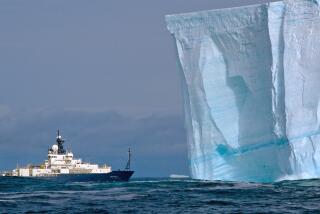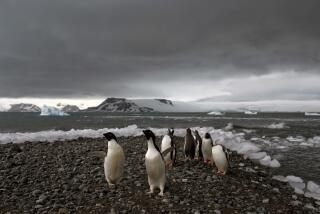What Visitors Need to Know About Antarctica
- Share via
Imagine people paying thousands of dollars for the privilege of bundling up in parkas and thermal underwear, making fools of themselves stumbling into bobbing inflatable dinghys in roiling seas, slipping on slime-covered rocks and falling into bone-chilling waters while trying to wade ashore, then trudging through mountains of foul-smelling penguin poop.
Meanwhile, they face hellish seasickness, temperatures so cold that 40 degrees seems like a balmy day and the proviso that becoming separated from their group while on shore could be a matter of life or death.
But increasing numbers of people return from a trip to Antarctica to announce that the journey was worth every penny, one of the great experiences of a lifetime. Voyages to the “Deep South” are becoming a hot ticket.
What’s to see, you may ask? Well, let’s start with what isn’t: pollution, traffic, insects, crowds, noise, to name a few. There are also no cities, save for a few scientific research centers, such as the American base at McMurdo Sound. Shopping is limited. There are few sights, unless you count something such as Sir Ernest Shackleton’s hut at Cape Royds, a remnant of the heroic era of antarctic exploration.
So what’s the attraction? Possibly one of the most beautiful places on earth. Rather than just ice and snow, as some suspect, Antarctica is a land of majestic peaks fading into the mist, massive icebergs sculpted by nature’s artistry, seas and shorelines teeming with rare birds and mammals, unsullied by man’s presence.
Which brings up the issue of tourism. Some environmental groups have attacked the idea of sending tourists to Antarctica, arguing that the continent is perhaps the most fragile ecosystem on earth and can barely withstand even mild human assaults on its shores. Already, they contend, careless research bases are polluting the land, and a burgeoning tourist business would irreversibly destroy it.
Although last Sunday more than 30 nations signed a historic accord banning mining and oil exploration in Antarctica for the next 50 years, there are currently no international regulations govering tourism to the continent. Last summer, however, a group of the largest North American tour companies operating cruises into the area formed a lobbying organization to dispel what it believes are “grave misconceptions” about antarctic tourism.
The new group, called the International Assn. of Antarctica Tour Operators, adopted a code of conduct to promote environmentally sound travel, although it stressed that its members have adhered to these rules for years. Among their pledges: that at least 75% of an expedition’s staff must have prior antarctic experience; that a qualified naturalist accompany a maximum 20 to 25 passengers ashore; that visitors must stay at least 20 feet away from penguins, crawling seals and nesting birds; that all litter must be returned to the ship, and that smoking is not allowed anywhere on shore.
Also, last year the National Science Foundation, responsible for the U.S. antarctic program, began sending representatives along on selected trips in order to monitor both the behavior of tourists and the naturalists accompanying them.
Beyond environmental concerns, there are several other things to consider about a trek to Antarctica.
First, unless you are wealthy enough to charter your own ship or airplane, or have connections at one of the scientific research stations, you must make arrangements with a tour company, and you will be part of a group.
Second, the trip requires a great deal of planning. Unlike destinations such as Europe, severe weather limits tourism to the short austral summer, primarly December through February. And there are only six ships--the prime mode of travel--that make the voyage. Early booking is the best plan since many of the best cruises fill up six months to a year in advance.
Third, itineraries can be unpredictable due to suddenly changing weather, and movement is highly restricted. You will be allowed ashore at designated intervals, and for set periods of time. Once on land, you cannot roam outside your group. So for the loner who hates groups, being told what to do and when to do it, this may not be the trip of choice.
And then there’s the cost. About the lowest you can expect to pay is $5,000 per person, and the price rises to as much as $60,000 for long-term, highly specialized adventures. Often these prices don’t include air fare. And many Southern Californians--save perhaps skiers--may have to add the cost of buying suitable cold-weather clothing and gear.
There are only a few operators who run expeditions to the antarctic, but any full-service travel agent should be able to arrange your reservations.
In choosing a cruise, the number of passengers aboard the ship will be a factor in the amount of time that you will be able to spend on shore. Larger ships must send more groups ashore for shorter periods; on the other hand, cruises on large ships tend to be cheaper.
Below is a selection of some of the best-known tour operators offering voyages to Antarctica.
SOCIETY EXPEDITIONS
Having recently joined in a marketing and sales agreement with Abercrombie & Kent, Society Expeditions operates two ships, the 98-passenger Society Explorer and the 139-passenger World Discoverer. Prices range from $4,990 to $17,790 per person; air fare is not included. Tours leave from Miami. For the upcoming 1991-1992 season, the ship sails from South America to the Antarctic Peninsula (West Antarctica). Expedition lengths range from 15 to 22 days. However, all cruises are booked except for a 17-day cruise departing Dec. 7, with lower-cost accommodations still available but filling up fast. Accommodations are on the luxury side and boast recognized naturalists and expedition leaders.
Contact Society Expeditions, 3131 Elliot Ave., Suite 700, Seattle, Wash. 98121, (800) 548-8669 or (206) 285-9400. Or Abercrombie & Kent, 1520 Kensington Road, Oak Brook, Ill. 60521-2141, (800) 323-7308.
MOUNTAIN TRAVEL-SOBEK
This adventure-travel expert also books Society Expedition ships as well as cruises on the Illiria, a 135-passenger luxury liner that has ventured numerous times to Antarctica. Cabins are still available on Illiria’s 15-day cruises departing Dec. 19 and 27, Feb. 1 and 29. Pieter J. Lenie, former captain of the National Science Foundation vessel Hero is the featured Antarctica expert on board. Prices range from $5,395 to $8,995; air fare is not included.
Contact Mountain Travel-Sobek, 6420 Fairmount Ave., El Cerrito, Calif. 94530, (800) 227-2384 or (415) 527-8100.
SALEN LINDBLAD CRUISING
Salen Lindblad operates what is considered the state-of-the-art expedition vessel, the 164-passenger M.S. Frontier Spirit. It will not return to East Antarctica, with sailings out of Tasmania, until the 1992-93 season. This year’s cruises depart South America Nov. 26, Dec. 16 and 22, Jan. 7 and 26 and Feb. 14. All have available space in all price ranges. Cost: $5,660 to $14,650; air fare is not included.
Contact Salen Lindblad Cruising, 333 Ludlow St., Stamford, Conn. 06912-0076, (800) 223-5688.
OCEAN CRUISE LINES
Ocean Cruises offers the lowest-price Antarctica trips and the biggest ship, the 450-passenger Ocean Princess. Closer to a full-fledged luxury liner than an expedition ship, the Ocean Princess has three departure dates this season: Dec. 20, Jan. 6 and 20. However, at press time the latter two cruise dates were nearly sold out. On board all cruises is adventure travel pioneer Lars-Eric Lindblad (he has no connection with Salen Lindblad), who gives popular daily briefings. Drawback to this big ship: Since only 100 passengers at a time are allowed ashore, scheduling and expedition times are tighter than on smaller boats. All tours last 19 days and include tours of the Falkland Islands and Tierra del Fuego, plus a two-night stay in Buenos Aires. Prices range from $4,595 to $7,995, though lower-priced cabins are already booked this season. Air fare add-on from LAX is $895.
Contact Ocean Cruise Lines, 1510 S.E. 17th St., Fort Lauderdale, Fla. 33316, (800) 556-8850 or (305) 764-3500.
More to Read
Sign up for The Wild
We’ll help you find the best places to hike, bike and run, as well as the perfect silent spots for meditation and yoga.
You may occasionally receive promotional content from the Los Angeles Times.






